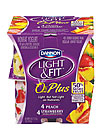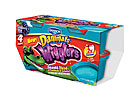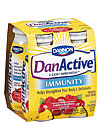
In 2006, The Dannon Co. set a bold goal: to double production by 2010. Now halfway through its four-year plan, the company’s top management says the push is progressing on schedule.
And it’s Dannon’s Activia brand – valued at nearly $2 billion in global sales – that’s doing most of the pushing. Its launch in the United States two years ago was one of the most successful new food product introductions in history; Dannon’s annual U.S. sales surpassed $1 billion just a year ago. Activia, and the DanActive cultured beverage launched not long after, established a new beachhead in the United States for probiotics, setting the tone for Dannon’s aggressive development of the category.
“Suddenly these two brands that didn’t exist 27 months ago are about 40 percent of our total business,” Juan Carlos Dalto, president and chief executive officer, says in an interview at Dannon’s headquarters in White Plains, N.Y. “These two brands are transforming the way people view the yogurt market. They’re helping us to transform the shelf, which is one of our key obsessions. Clearly, we have been adding value in a tough time for the dairy industry.”
Dannon has since followed up with light versions of both products; launched a 0% Plus version of Light & Fit, its former highest-volume product; and enhanced its kids’ offerings, including a proprietary probiotic culture for the Danimals line.
But when asked how close Dannon is to overtaking Yoplait as the U.S. yogurt brand leader, Dannon’s executive team takes a broader perspective. “The objective is category growth through innovation,” says Michael Neuwirth, senior director of public relations. “Market share will come from that.”
Dalto does note that Dannon is the overall leader when including organic yogurt leader Stonyfield Farm, in which Dannon’s parent, French-based food giant Groupe Danone, holds the majority stake. Still, the attitude is one of letting the chips fall where they may after delivering on promises of quality and service.
“We look at who’s bringing the most category management, the most resources,” Dalto says. “There isn’t anyone else who can bring the worldwide resources we can bring.”

What's in store
A significant chunk of those resources are going toward redeveloping the yogurt category at the retail level, which Dannon views as crucial to the future of the segment. Jim Murphy, senior vice president of sales, says store dairy cases are in dire need of increased footage to accommodate such a rapidly expanding category.“Yogurt runs out of stock twice the grocery average [due to lack of space compared to product demand]. That’s a lot of money left on the table,” Murphy says. “When we launched Activia, it was at the expense of our other products. We have to stop it from becoming a zero-sum game whenever a new product is launched.”
Dannon sees this as so important to its future growth that it formed a “shelf-obsession team” nine months ago to focus on growth strategies with retailers. “We literally mapped every store in the United States to understand our constraints,” Murphy explains. “Many retailers are planning three, four years out. We have to work with them now. Every retailer agrees there’s a space need in the category.”
And products like Activia are helping the country play catch-up; Murphy notes that other countries have six times the per capita consumption of yogurt as in the United States. “We’ll spend $8 million to $9 million just on shelf needs to better position retailers for the future,” he says, noting the company is working with Dairy Management Inc. on coming up with solutions. “We’ve hit the wall on low-hanging fruit. The big opportunity is in the long-term solution of breaking down the walls of the category so it can double every five years.”
Dannon has 140 direct-sales people for grocery, plus a staff of contract people on its retail team. “We’re going counter to the industry. Where most may be peeling back, we’ve doubled our team,” Murphy says. “If we push the category, it’s good for us and the retailer.”
It’s all part of what Dalto calls “valorizing” the category. “You can do business by commoditizing the category; but we don’t want to do that,” he says. “We immediately bring value to the consumer. If you do that, we believe there are no limits to the category.”
Dannon is adding value to its marketing efforts as well. Not content with just basic sampling to sell its products, the company has nutritionists visit stores to help educate consumers. “These products don’t always explain themselves,” Murphy says. “The retailers couldn’t be happier with the impact on sales and consumers are impressed the company went the extra mile. It’s all about expanding the category and getting new consumers on a daily basis. Until Activia, there was no food product in the U.S. you had to consume every day in order to realize the benefit. You could come in and out of it [the category].”
Crucial to maintaining that frequency of use is taste. “It’s not medicine,” says Marc Jove, vice president of marketing. “If it doesn’t taste good, you won’t get the benefit because you won’t eat it.”
Hence the spectrum of flavor profiles Dannon must contend with as part of a global concern. “Food is local. When it comes to taste, the U.S. is different,” Jove says, noting yogurt tends to be sweeter here than elsewhere in the world. “In Argentina, it’s even sweeter. In Europe, it’s less sweet. It’s common sense – you have to adapt to the local palate.”
Fat levels differ, too; for example, in the States the “full fat” version of Activia, which is a low-fat product, contains 2 grams of fat, while abroad it’s twice that.
Dalto says Dannon is “very satisfied” with the evolution of the Activia and DanActive brands, and future product launches may include extensions of these key marques.
The goal moving forward, Murphy says, will be to drive new usage. “We’re focused on growing this category, and it’s expensive to grow,” he says. “The good news is, the retailers are willing to invest in it, too. They’re convinced as we are that there’s potential in this category.”

Supporting and sustaining
Halfway toward its goal of doubling output by 2010, Dannon is on firm ground. “Second semester this year, we’ll be in much better shape for capacity,” Dalto says, outlining investments at the manufacturing level. “It’s been a challenge for us; it was hard to predict the success of Activia… [but] the best is yet to come. We’re halfway but in a more comfortable situation. We should enjoy our best customer service levels in years to come.“We not only expanded capacity but the ‘right-sourcing’ of capacity,” Dalto continues, noting that Dannon converted each of its three plants – in Ohio, Texas and Utah – into regional facilities that each make most of the company’s top-selling SKUs. “You significantly reduce transport miles.”
That’s just one aspect of Dannon’s overall sustainability program – the first of which was to create sustainable products like the daily-use Activia and DanActive. Now the push is on environmental sustainability, which actually began three years ago when Dannon dropped clear plastic overcaps from its preform cup yogurts in favor of a single foil seal.
“We want to put much more focus on this and accelerate it,” Dalto says. “We lead the market in moving from preform cups to form-fill-seal technology.”
In addition to FFS, which uses 30 percent less plastic, Dannon has also reduced the weight of the plastic bottles used for its drinkable products. Further, the company is making its plants “wall to wall” facilities by bringing key supplies closer to plants or even on site, in the case of blow-molding operations in Ohio and Utah.
Dannon recently convened its first internal sustainability summit and expects to soon appoint a director of sustainability. “So we embrace this, 360 degrees through the company,” Dalto declares. “Groupe Danone’s sustainability obsession is upfront in the agenda.”
The panel will be charged with determining the company’s “carbon footprint” and setting specific goals for reducing natural resource usage. And this year, Dalto says, bonuses for management-level employees will be based in part on sustainability success.
Meanwhile, Dannon is grappling with the rising costs of energy and commodities that have challenged most businesses. “We had to become much more efficient internally and cost-conscious” to minimize the impact on product pricing, Dalto says. “We’re facing all the challenges we had last year … but we’re not stopping any investments in capacity, production, quality, safety or investing in our brands.”
Dalto says internal discussions focus more on how Dannon can best serve its markets rather than dwelling on economic issues like whether or not the country is in a recession. “We’re prepared for a market that could be much more challenging … We don’t foresee going back to 2006 levels [of costs for energy and commodities],” he says. “We believe consumers will be loyal to our products. We’ve grown double digits, and the market has grown nicely in the last few months.”

Lessons learned
What has Dannon taken away from the powerhouse that is Activia?“It was a bigger success than we expected because we had doubts American consumers would respond as quickly as other consumers [outside the U.S.],” Dalto says. “The [explanation of the] benefit of Activia on slow transit resonates in the U.S. because of the prevalence of digestive health issues. The American market is proving to be more similar than different from other markets.”
So what was it that finally clicked in the minds of U.S. consumers about probiotics, a dietary concept that’s been the norm for decades abroad?
“It didn’t just happen,” Neuwirth says, noting that Dannon essentially created a new market for probiotic products based on sound science and clinically proven products.
Dalto adds: “We did what had to be done – introduced a product clinically proven that does what it promises. We made an investment that no one ever had before.”
Along with successfully educating consumers to Activia’s benefits – a campaign that has come to include actress Jamie Lee Curtis as a spokesperson – Dannon secured key partnerships at the store level. “We wouldn’t have been successful without key buy-in by the retailers. They have been very willing partners. It’s been an important part of our success,” Murphy says.
He likens it to the bottled water category 15 years ago, when retailers began to expand space to accommodate all the new products and the category took off. “They had to buy into it six months before we launched it,” Murphy says. “It’s a shared responsibility.”
Dannon’s leadership is convinced that cultivating this trifecta of company, consumers and retailers is key to not only Dannon’s future, but to the ultimate destiny of the cultured category and the dairy industry.
“It’s about growing integrity, building the category and meeting consumer needs,” Jove says. “It’s a win-win-win game we can all play.”

History
The Dannon Co. Inc. has its roots in Spain, where Danone was founded by Isaac Carasso in 1919. Having previously lived in the Balkans where yogurt was a dietary staple, Carasso decided to introduce this healthy product in Barcelona. He opened a small yogurt business named “Danone,” meaning “Little Daniel,” after his son.Carasso was aware of scientific advances that had been made with fermented milk by Elie Metchnikoff at the Pasteur Institute in Paris. He perfected the first industrial manufacturing process by combining the traditional method of making yogurt with the pure cultures that had been isolated in Paris. The younger Carasso, Daniel, learned the family business in Spain and decided to establish Danone in France in 1929.
During World War II, Daniel Carasso immigrated to the United States. In 1942, he founded the first American yogurt company, Dannon Milk Products Inc., in the Bronx, N.Y., changing the name to make the brand sound more American. In 1943, Carasso met Joe Metzger, who helped him with the administrative work of the new company.
Dannon faced a major hurdle at its inception: Few Americans had ever tried yogurt, then a staple in many European countries. Distribution was very limited at first and was confined to the local New York area.
In 1947, a breakthrough came when Dannon introduced yogurt with strawberry fruit on the bottom. This innovation appealed to Americans who found the sweetness of the fruit to be the perfect complement for the tart taste of yogurt. Blueberry and raspberry fruit, as well as orange and lemon flavors, were quickly added to the product line and started to become the favorite yogurt of America. The company grew rapidly and, in 1950, moved to a larger facility in Long Island while expanding its sales area to Philadelphia and Boston. Dannon then introduced a low-fat yogurt designed to appeal to health enthusiasts and dieters.
In 1951, Daniel Carasso returned to Paris to manage the family’s businesses in France and Spain. He gave the management and the presidency of Dannon to Joe Metzger (helped by his son Juan) with the objective of looking for an eventual buyer. Daniel Carasso maintained regular contact with Dannon by frequent trips to America and regular correspondence with the Metzgers. Dannon Milk Products Inc. was sold to Beatrice Foods in 1959 with unanimous consent of its board of directors.
During the 1960s, Beatrice embarked on a rapid westward expansion of Dannon, acquiring a second manufacturing facility in Minster, Ohio. In 1979, a plant was opened in Fort Worth, Texas, and Dannon became the first perishable dairy product sold coast to coast.
While Dannon was growing in America, Daniel Carasso was leading Danone to rapid development in Europe. To accelerate its diversification and world expansion, Danone merged with Gervais, the leading fresh cheese business in France in 1967, and with BSN, the leading glass container and beverages company, in 1973. The resulting company, BSN Gervais Danone, became one of the world’s largest food manufacturers, present in 30 countries worldwide. In 1994, BSN Gervais Danone took the name Groupe Danone.
In March 1986, Dannon moved its headquarters to White Plains, N.Y. During the next decade, Dannon introduced new, highly successful products such as Dannon Light, Blended and Danimals.
SOURCE: www.dannon.com

The Dannon Family of Products
A pioneer in the development of the yogurt market in the United States, Dannon has again transformed how American consumers view the category.Leading the company’s current portfolio is Activia, a low-fat yogurt that contains Bifidus Regularis, a proprietary natural probiotic culture that Dannon says is clinically proven to help regulate the digestive system by helping reduce long intestinal transit time when eaten daily.
Released in the United States in 2006, Activia is available in four-, eight-, 12- and 24-packs of 4-ounce cups in regular and light, in an array of fruit flavors plus vanilla; and 24-ounce tubs in plain and vanilla.
DanActive is a cultured probiotic drink that contains a unique combination of beneficial live cultures, including Lactobacillus casei Immunitas. Each bottle of DanActive contains more than 10 billion cultures and has been clinically proven to help strengthen the body’s defenses. Launched in Europe in 1994 to great success, and later released in Asia, the product’s U.S. launch came in January 2007.

Dannon’s line designed for children, Danimals contains LGG, a proprietary probiotic, said to help kids stay healthy as part of a balanced diet and healthy lifestyle. Danimals also contains no high fructose corn syrup and claims to have twice the calcium of other kids’ yogurt.
Danimals comes in cup and drinkable varieties in several flavors and in a drinkable Xtreme range with flavors like Banana Guava Cliffhanger and Smashin’ Passionfruit.
The biggest seller among Dannon’s brands before the launch of Activia, the Light & Fit line includes 0% Plus, Nonfat Cups and Smoothies, and Carb & Sugar Control in spoonable and drinkable formats. The fat-free 0% Plus contains added calcium, vitamins and protein, plus 50 percent more fruit than other comparable yogurts, all at 60 calories per serving.
Rounding out Dannon’s products are Fruit Blends, a low-fat yogurt sold in multipacks of 4-ounce cups; Fruit on the Bottom low-fat 6-ounce cup yogurts in 10 fruit flavors, available in single cups and club packs; la Crème, a rich dessert-style yogurt; All Natural plain, blended and flavors; and Frusion low-fat fruit and yogurt smoothies in single 10-ounce bottles and 4-packs of 7-ounce bottles.